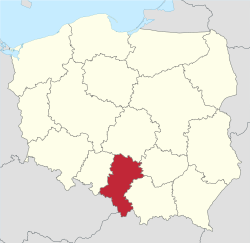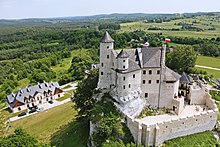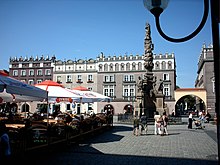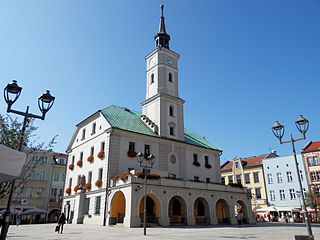| |||
| Silesia (Voivodeship) | |||
| Capital | Katowice | ||
|---|---|---|---|
| Residents | 4.617.000 () | ||
| surface | 12,333.09 km² | ||
| no tourist info on Wikidata: | |||
| location | |||
 | |||
&groups=Maske,Track,Aktivitaet,Anderes,Anreise,Ausgehen,Aussicht,Besiedelt,Fehler,Gebiet,Kaufen,Kueche,Sehenswert,Unterkunft,aquamarinblau,cosmos,gold,hellgruen,orange,pflaumenblau,rot,silber,violett)
The voivodeship Silesia (Polish Województwo śląskie) is the eastern part of the Greater Silesia region and lies in the southern part Poland. It borders the voivodeships to the east Holy Cross and Lesser Poland, in the south to the Slovakia and Czech Republic, in the west to the voivodeship Opole and in the north to the voivodeship Łódź. The voivodeship is divided into three parts from north to south into White Silesia (Karst des Krakow-Czestochowa Jura), Black Silesia (Upper Silesian industrial area with heavy industry and mining) and Green Silesia (mixed mountain forests of the Beskids):
There are numerous rock formations, caves and castles in the Jura. The karst region is popular with hikers, climbers, riders, water sports enthusiasts and, in winter, with cross-country skiers. The only desert in Central Europe is located here in the Błędów district of Jaworzno.
In the metropolises of Upper Silesia there is a rich cultural offer of museums, galleries and concerts. Several of today's industrial cities go back to the Middle Ages and have preserved architectural monuments from the Gothic, Renaissance and Baroque periods. From the late 18th century onwards, coal mining flourished and numerous buildings were built in the style of Classical, Historicism and Art Nouveau. Modernism shaped its architecture from the interwar period and social realism shaped the period of the early People's Republic. Since the end of the 20th century, in particular Katowice numerous postmodern skyscrapers.
In the south there are beautiful mountain ranges among which the Saybuscher Beskids with approx. 1600 m (Pilsko), the Silesian Beskids with about 1300 m (Skrzyczne) and the Little Beskids with about 1000 m are the highest. That closes to the north Silesian promontory and the Auschwitzer Basin on. On the western slope of the Widderbergs the originates Vistula, which is the longest river in Poland with over 1000 km and has been largely exempted from commercial shipping to this day.
Regions



The Silesian Voivodeship consists of several regions. In the south lie the Saybuscher and Silesian mountain ranges Beskydy Mountains. The closes in the northeast Krakow-Czestochowa Jura which historically belongs to Lesser Poland. The middle represents the Silesian plateau. In popular parlance, Silesia is divided into three regions from north to south. The northern part is known as White Silesia due to the limestone cliffs of the Jura, the middle as Black Silesia due to the coal deposits in the Upper Silesian industrial area and the southern part as Green Silesia due to the dense forests of the Beskids.
The name possibly comes from the prehistorically important cult mountain Ślęża (Latin: Silensi, German: Zobtenberg), which is however in Lower Silesia is located. According to other theories, they were Slavic Slensans or the Germanic Silingen eponymous. The name Silesia is initially confusing, because the voivodeship only includes the eastern edge of historical Silesia. It has no share in Lower Silesia and only partially in Upper Silesia. However, the voivodeship is the most populous part of historical Silesia.
Most of the region is made up of historic Upper Silesia, its capital Opole originally, which is not in the voivodeship today. Larger parts also belong to the east Lesser Poland to the Silesian Voivodeship. Parts of the north are in the historical Greater Poland. Instead, parts of historical Upper Silesia are now in the voivodeships Opole and Lesser Poland and to a small extent also in Czech Republic.
- The voivodeship has a share in the north Krakow-Czestochowa Jura with its chalk cliffs
- Much of the Woischnik-Welun plateau is in the voivodeship.
- The voivodeship has a share in the north and the center Silesian plateau.
- The upper one runs through to the southwest Odertal the Silesian Plain in the voivodeship.
- It joins the Oder Valley to the east Vistula valley with the Auschwitz basin at.
- The one to the south of it Silesian promontory lasts until after Lesser Poland.
- The voivodeship has a share in the south West Beskids.
- The Silesian Beskids is located in the border triangle Slovakia and Czech Republic.
- The Little Beskids join the Silesian Beskids to the east.
- The Saybuscher Beskids are in the extreme south on the border with Slovakia.
- That lies between the mountain ranges of the Beskids Saybuscher basin with its reservoirs.
places
Woischnik-Welun plateau
Krakow-Czestochowa Jura
- 7 Koniecpol

- 8 Szczekociny

- 9 Mirów
- 10 Bobolice

- 11 Olsztyn
- 12 Żarki

- 13 Myszków

- 14 Zawiercie

- 15 Poreba

- 16 Siewierz

- 17 Łazy
- 18 Ogrodzieniec

- 19 Pilica

- 20 Smoleń
Silesian plateau
- 21 Lubliniec

- 22 Kalety

- 23 Tarnowskie Góry

- 24 Miasteczko Śląskie

- 25 Radzionków

- 26 Toszek

- 27 Pyskowice

- 28 Sośnicowice

Upper Silesian coal basin
- 29 Gliwice

- 30 Zabrze

- 31 Bytom

- 32 Piekary Śląskie

- 33 Ruda Śląska

- 34 Siemianowice Śląskie

- 35 Chorzów

- 36 Świętochłowice

- 37 Katowice

- 38 Mysłowice

- 39 Mikołów

- 40 Tychy

Non-Polish brazier
Rybnik brazier
- 48 Knurów

- 49 Czerwionka-Leszczyny

- 50 Orzesze

- 51 Łaziska Górne

- 52 Rybnik

- 53 Żory

Odertal
- 54 Kuźnia Raciborska

- 55 Rudy
- 56 Racibórz

- 57 Krzanowice

- 58 Rydułtowy

- 59 Pszów

- 60 Radlin

- 61 Wodzisław Śląski

- 62 Jastrzębie-Zdrój

Vistula valley
Silesian promontory
- 68 Cieszyn

- 69 Goleszów

- 70 Skoczów

- 71 Czechowice-Dziedzice

- 72 Wilamowice

Silesian Beskids
Little Beskids
Saybuscher Beskids
Other goals


Kayak trails
Lakes
.jpg/220px-2012_Powiat_pszczyński,_Studzionka,_Widok_z_drogi_wojewódzkiej_(04).jpg)
- 1 Czarne reservoir
- 2 Gottschalkowitz reservoir
- 3 Miedzybrodzie Reservoir
- 4 Big Sersno reservoir
- 5 Small reservoir Sersno
- 6 Żywiec reservoir
Other goals

- The 1 Pless Castle is one of the most beautiful renaissance castles in Europe.
- The 2 Ogrodzieniec Castle is one of the most beautiful castle ruins in Central Europe.
- Through the 3 Silesian Beskids and the 4 Saybuscher Beskids in the West Beskids in the south leads the Beskydy main hiking trail.
- Through the 5 Little Beskids in the West Beskids in the south the Small Beskydy hiking trail.
- Through the 6 Krakow-Czestochowa Jura in the north the Adlerhorst castles hiking trail.
- The 7 Plesser heather (Polish Puszcza Pszczyńska) between the Oder and the Vistula is one of the largest contiguous forest areas in the region.
- The 8 Lublinitzer Heide (Polish Lasy Lublinieckie) northeast of the Oder is also one of the largest contiguous forest areas in the region.
background
Today's Silesian Voivodeship comprises the eastern part of Upper Silesia, parts of western Lesser Poland and the so-called Teschener Silesia. These areas had a partially different history. Teschen is one of the oldest cities in Poland and already existed at the time of the Great Moravian Empire. Lesser Poland and Upper Silesia also belonged to the Great Moravian Empire. From around 990 all these areas belonged to Poland.
In the 14th century Teschen and parts of Upper Silesia came to Bohemia and in the 16th century to the Habsburg monarchy, while Lesser Poland remained Polish until the first partition of Poland in 1772. After the Silesian Wars, Upper Silesia became Prussian, while Teschener Silesia remained with Austria. After the First World War, almost the entire area came to Poland. The west around Gleiwitz became part of the Weimar Republic. After the Second World War, this part also became Polish. Today's Silesian Voivodeship was founded in 1999 from the areas of four old voivodeships.
To this day, Upper Silesia has strong cultural peculiarities that differ from the rest of Poland and many people identify strongly with their region. In the 2011 census, around 700,000 inhabitants indicated their ethnicity as “Silesians” (around half of them only Silesian, the rest of them Silesian and Polish). Another 32,000 identify as Germans.
language
The official language of the Silesian Voivodeship is Polish, with a Silesian, Lesser Poland or Goral dialect depending on the region.
Most Poles also speak good or very good English. Some also have a second foreign language such as German, Russian, Spanish, French or Italian, which are mainly spoken and understood in the large and tourist-relevant cities.
getting there

.jpg/220px-Autostrada_A4_w_Zabrzu-Makoszowach_(Nemo5576).jpg)
By plane
In Katowice lies the international 1 Katowice Airport![]() (IATA: KTW), including connections from Germany, Austria and Switzerland.
(IATA: KTW), including connections from Germany, Austria and Switzerland.
Also for 2 Krakow Airport![]() (IATA: CRC) at Krakow in the voivodeship Lesser Poland there are connections from Germany.
(IATA: CRC) at Krakow in the voivodeship Lesser Poland there are connections from Germany.
By train
The rail network is very good and well developed. It is the densest in Poland.
Three continuous Trilex trains run from Dresden every day Gorlitz and Legnica to Wroclaw and on to Katowice.
From Berlin there are connections with a change in Poses from the EC to other trains to Katowice.
The state railway company PKP provides two information services on the web: one Travel information as intercity.pl to book your own long-distance transport offers. Both pages are also available in German, English and Russian.
One operator of local trains in Silesia is Koleje śląskie (kś). The company is 100% owned by the voivodeship. The Website of the kś provides information on local rail transport, timetables and prices. The site is also available in German and English. After this page, the purchase of tickets on the train is from the conductor. Stationary ticket machines usually also accept credit cards.
By bus
Numerous bus companies offer long-distance connections via Katowice.
In the street
The road conditions are very good and well developed. The road network is one of the densest in Poland. The motorways are very well developed. In Silesia, the A4 is usually three-lane and illuminated. The A1 is almost finished. There are numerous expressways. There are many supraregional trams and buses in the Upper Silesian industrial area with its almost 5 million inhabitants.
The journey from Germany is recommended via Dresden on the autobahn A4 or via Berlin over on the A18 motorway, which is east of Bolesławiec meets the A4.
mobility
The road network is one of the densest in Poland. This also applies to train connections.
Tourist Attractions
The medieval towns, castles and palaces as well as the cultural offerings of the metropolises of the industrial area are particularly worth seeing. There are many Silesian wooden churches in the voivodeship.
- Vistula springs in the Beskydy Mountains
- Bielsko-Biała and the winter sports resorts Ustroń, Wisła and Szczyrk in the Silesian Beskids.
- Bytom(Bytom) is home to the Upper Silesian Museum and is heavily influenced by heavy industry.
- Chorzów was conceived as a leisure city in the 1960s and has a large amusement park with a planetarium, dolphinarium and zoo.
- Cieszyn(Teschen) is a city with beautiful historical buildings on the border with the Czech Republic.
- Czestochowa(Czestochowa) has the most famous monastery in Poland, which is one of the most important pilgrimage sites in Central Europe due to the so-called Black Madonna.
- Gliwice(Gliwice) has a medieval old town and in its vicinity is the wooden transmission tower Gleiwitz, which played an inglorious role at the beginning of the Second World War.
- Katowice(Katowice) is the capital of the voivodeship and has a rich cultural and night life with numerous shopping opportunities.
- Ogrodzieniec is the largest castle ruin in the Jura.
- Pszczyna(Pleas) owns one of the most beautiful castles in Silesia.
- Rajcza is the tourist center of the Beskydy Mountains.
- Tychy(Tichau) is home to a brewery founded in 1629 (Tyskie) and with this part of the European Route of Monuments of Industry and Technology.
- Żywiec(Saybusch) is home to a brewery founded in 1856 (Żywiec). Historic city with castles, co-cathedral and reservoir.
activities
The mountains offer hiking, climbing, kayaking, cycling, horse riding and winter sports. The Little ones, Saybuscher and Silesian Beskids are popular with winter sports enthusiasts and hikers. This also applies to the Krakow-Czestochowa Jura. This is where one of the most beautiful castle ruins in Europe lies, the castle Ogrodzieniec.
kitchen
In Poland, the Silesian cuisine is particularly hearty, tasty, meaty but also rich in calories. Silesia is also home to the most famous Polish beer brands such as Żywiec, Brackie and Tyskie. For Polish cuisine, see the relevant section in the article about Poland.
nightlife


There are many clubs, bars and restaurants in the metropolises of Upper Silesia. There are some quaint restaurants in the Silesian Beskids.
security
It is actually quite safe, but it should be used in large crowds e.g. B. in large markets or train stations - as everywhere in the world - do not neglect the necessary care.
climate
The climate is a transitional climate from temperate to continental. The summers are generally warm to hot with mean temperatures between 16 ° C and 21 ° C and the winters are cold, with mean temperatures around -5 ° C. Precipitation falls mainly in spring and autumn, although the amount of precipitation is lower than in western Poland.
literature
See article too Poland.
Web links
- http://www.silesia-region.pl (pl) - Official website of the Silesian Voivodeship
- Website of the Polish Tourist Office for the Silesian Voivodeship















_(2).jpg/320px-MOs810_WG_2018_8_Zaleczansko_Slaski_(market_square_in_Krzepice)_(2).jpg)


















.jpg/350px-Lubliniec_-_panoramio_(12).jpg)


.jpg/350px-SM_Miasteczko_Śląskie_Kościół_Wniebowzięcia_NMP_2018_(6).jpg)


























.JPG/350px-Ober_Lazisk_-_Rathaus_(2013).JPG)


.jpg/320px-Kuźnia_Raciborska,_Kościół_św._Marii_Magdaleny_-_fotopolska.eu_(27319).jpg)







.jpg/350px-2012_Jastrzębie-Zdrój,_Park_Zdrojowy,_Dom_Zdrojowy_(04).jpg)

.jpg/350px-2012_Powiat_pszczyński,_Pszczyna,_Pałac_(04).jpg)























.jpg/350px-2012_Powiat_pszczyński,_Studzionka,_Widok_z_drogi_wojewódzkiej_(04).jpg)










.jpg/320px-John_Paul_II_Airport_in_Balice-Kraków_night_november_2017(3).jpg)



